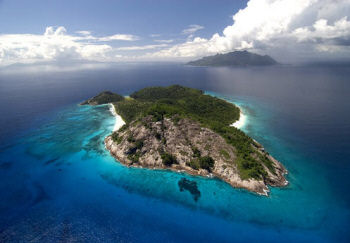|
|
|
 |
Combines
an ecological restoration project
and and architectural masterpiece by Sylvio Rech and Leslie Carstens. |
|
Indian Ocean |
| The
Seychelles Islands form an archipelago of 115 islands, comprising some
of the most isolated islands in the world, and encompass two World Heritage
Sites. The islands have a population of 80,000 Seychellois, most
of whom live on Mahé. The 40 inner islands centred around Mahé
and Praslin, the world's only granite ocean islands, are the remnants of
the mountain peaks of Pangea, the ancient super-continent that once encompassed
all the earth's landmasses. Around 125 million years ago, continental
drift split Madagascar, Seychelles and India broke away from Larasia.
Madagascar became an island around 90 million years ago - its isolation
resulting in the evolution of its own unique fauna and flora. 65 million
years ago, at around the time the dinosaurs became extinct, Seychelles
broke away from India. The outer islands are coralline. They are made up
of coral or volcanic rocks, which have grown out of the ocean as a result
of events deep within the earths crust.
North Island and its neighbour Silhouette are granitic islands but as they are composed of a form of granite known as syenite it is thought that they are considerably younger than Mahé, Praslin and La Digue and that they may have formed around 90 million years ago when India and Seychelles separated. Seychelles is positioned at the northern bank of the submerged Mascarene Plateau and is a prime diving location. The Mascarene Plateau is a submerged volcanic ridge, which stretches from Seychelles to Mauritius. It covers an area of 115,000 square kilometres with depths ranging from eight to 150 metres and is more extensive than Australia's Great Barrier Reef. Corals are extremely slow growing organisms - some may be up 10,000 years old. They support large numbers of fish and other marine flora and fauna in a balanced and harmonious environment. Healthy reefs protect the shoreline and prevent erosion of beaches and fragile shore vegetation. Reefs also provide an important source of fish for local coastal communities whose survival depends on these reefs remaining healthy and sustainable. Seychelles is easily accessed via London, Nairobi and Johannesburg. Climate - Seychelles position just below the equator results in a warm, tropical climate throughout the year The southeast trade winds blow from April to October and the weather is cooler and drier during these months. The lighter northwest trade winds or monsoon, blow from November to February and bring heavy rain. This usually comes in the form of torrential downpours, which may last for a couple of hours. December and January are usually the wettest months with around 300 mm of rain being recorded on average. |
|
|
|
 |
Combines
an ecological restoration project
and and architectural masterpiece by Sylvio Rech and Leslie Carstens. |
|
African Business and Adventure Travel 2761 Unicorn Ln NW, Washington DC 20015 Tel (202) 244 5954 Fax (202) 244 5993 (800) 356-4433 home: www.capecairo.com / safari@capecairo.com |
 |